

How To Set Up A Robotics Center of Excellence?
As automation becomes common, robots take charge. They offer the world an opportunity to change, improve, and grow for the better. Therefore, gaining in-depth knowledge about their use, management, and hands-on experience is no longer a choice but a necessity. Gaining practical knowledge of robotics early on can prepare our future generations. Therefore, only a specialized, super advanced, and successful Centre of Excellence can make this possible.
Table of Contents:
- What is a Center of Excellence (CoE)?
- Why is a Robotics CoE Needed?
- Benefits of a Robotics CoE
- Steps to Setup a Industrial Robotic Lab Setup
- Fix a Budget:
- Train Qualified Faculty:
- Select and Invest in Excellent Equipment :
- Encourage Innovation and Practical Experience:
- Key Elements to Consider When Setting Up a Robotics CoE
- Essential Robotics Technologies to Incorporate
- Spot Welding Robot:
- Vision System:
- 2D Path Following:
- Voice Command Robot:
- Color Sensing Robot:
- Material Sensing Robot:
- Static Palletizing Robot:
- Magnetic Pick and Place Robot:
- Gluing Application Robot:
- Logistic Sorting System:
- Vacuum Gripping:
- Spray Painting Robot:
- Choose the Right Robotics with Autofina:
What Is A Center of Excellence (CoE)?
Any college/school’s Robotics Centre of Excellence is the epicenter for the latest Industrial Robotics education and research. Here, you’re not just surrounded by groundbreaking robotics; you’re also guaranteed to offer the best hands-on live experiences to future students.
In this center, teachers, staff, and students collaborate to explore the exciting realm of industrial robotic technology. So, everyone here benefits from top-notch study materials and equipment, propelling both academic research and practical applications. More than just imparting technical knowledge, a CoE emphasizes genuine problem-solving and creativity. Thus, these centers play a pivotal role in connecting academic research with emerging innovations.
Students can also physically engage with robotic devices and witness industrial processes in a dedicated robotics lab. This hands-on approach allows them to apply theoretical knowledge, understand the nuances of operations, and gain insights into real business scenarios. Such real-world exposure is crucial to bridge the knowledge divide between academic learning and industry needs.
Why Is A Robotics CoE Needed?
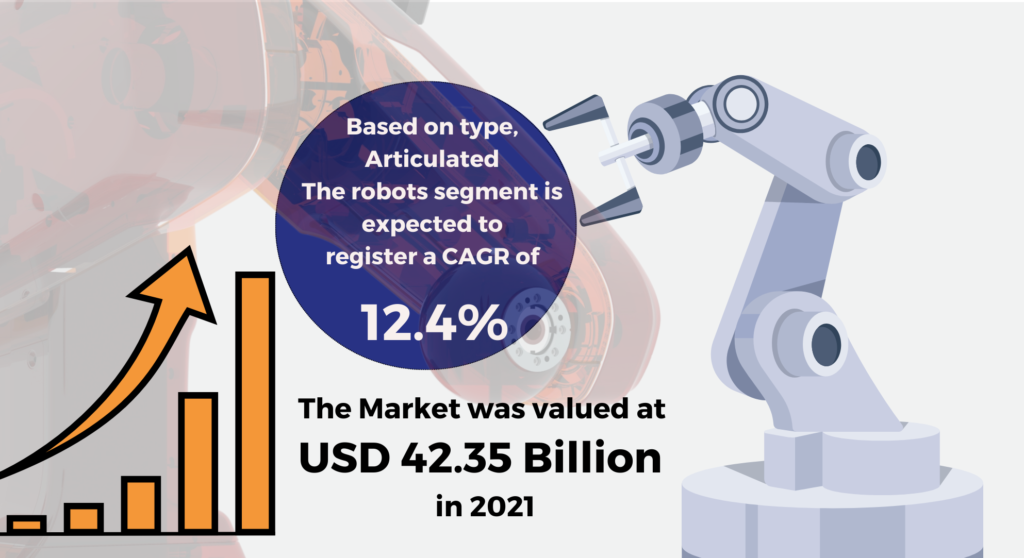

Statistic that shows how much the robotics market is estimated to grow.
Collaboration between different departments:
Computer science, mechanical engineering, hydraulics, pneumatics, electronic engineering and AI are just a few of the many genres of fields that actively makeup robotics. A CoE encourages a collaborative and interactive space where experts from all directions could work together. This helps to produce more genius and comprehensive solutions that wouldn’t be possible in separate departments.
Advanced Infrastructure :
Researchers in robotics often seek the best Industrial robots, tools, and study materials. A CoE essentially provides a one-stop access to these resources. This makes sure that students can leverage all technologies for optimal results.
Global Networking :
Industry leaders and peers from around the world closely watch Robotics CoEs. This attention makes your center the go-to spot for international cooperation, sharing high-quality information, undertaking global research projects, and accessing a wide range of financing and partnership options.
Benefits of a Robotics CoE Setup
For Students:


Access to Cutting-Edge Technology:
The field of robotics is constantly developing and has a high demand for skilled professionals. A CoE will make sure that students are exposed to the freshest devices, procedures, and technologies in order to keep them at the tip of innovation.
Hands-On Experience:
A robotics CoE gives students the chance to work on actual realistic robotic projects, giving them the chance to put their classroom learning into good use and get practical skills. This practical experience will prove to be very beneficial for future job opportunities and research. Data shows that automation is projected to generate more than 12 million jobs globally by 2025.
Better Payscale:
Students who study advanced robotics at a well-equipped CoE get practical experience and in-demand abilities. They become significant assets to companies because of their expertise. This often translates into greater starting salary, better employment opportunities, and more chances for professional growth, giving a competitive pay scale and package.


Payscale data that shows how much is the average package of a mechanical and robotics engineer.
Interdisciplinary Learning:
This is an area of study that combines multiple and broad parts of engineering, computer science, artificial intelligence, and more. Your Industrial Robotic Lab setup will encourage such cross-disciplinary interaction, allowing students to develop an in-depth grasp and tackle issues from various points of view.
Research & Innovation:
For students who will have a passion for deep technical research, a CoE will offer them the resources, guidance, and positive environment they need to innovate. They can do their part of contribution for the field and the world- resulting in patents, articles, great discoveries or starting a new business.
Career Growth:
Students who will take in all the possible benefits from a Robotics CoE definitely have a competitive edge when getting hired due to the increased demand for robotics professionals in fields like manufacturing and healthcare. They are going to be more qualified for positions globally in AI development, automation, robotics engineering, and so much more. According to LinkedIn, there are 46,020 job openings for robotic engineers.


Number of jobs on LinkedIn for a robotics engineer in India


Number of jobs on Naukri.com for a robotics engineer in India
Benefits For Colleges/Institutions:
Better Institutional Profile:
India’s higher education institutions are graded for quality by the NAAC (National Assessment and Accreditation Council). Your institution’s reputation is automatically enhanced with a positive NAAC rating. You can show your dedication to innovation and advanced learning by establishing a robotics centre of excellence and boost your NAAC score.
Strong Market Partnerships:
The CoE will become your bridge between theoretical and actual industrial use. This not only builds successful partnerships of your college with businesses either due to placements or job offers, bringing it to notice that your academic offerings align with today’s industry needs.
Attracting Academic Excellence:
A top notch Center of Excellence not only enhances your institution’s reputation but also creates your faculty into a place where the brightest of minds come together, collaborate, and contribute to the brilliant field of robotics. This way a CoE will not create a group of students who are skilled but also train the trainers(teachers, professors etc). Being the first institution in your city to establish this lab could significantly elevate your reputation and set you apart as a pioneering leader in the field.
Opportunities for Faculty:
A Robotics CoE supports cutting-edge research and development, giving professors plenty of resources for in-depth research. This scenario can greatly improve their chances of pursuing and earning PhDs.
Eager and Better Admissions:
Both passionate engineers and their parents will find it appealing if your establishment offers a dedicated Industrial Lab that supports their drive to learn robotics. Remember, an investment made by your admissions in a future of robotics will only come when you make them a promise to provide them the best in robotics.
Support for Entrepreneurial Ventures:
Beyond just ideation and learning, this center offers industrial mentorship, resources, and a great way to network, so all budding entrepreneurs have a solid foundation to think about, launch and sustain their startups.
Enhanced Placement Opportunities:
Your educational institution automatically becomes a top target for big tech firms looking for new talent. Companies are more likely to hire from universities known for their excellence in robotics. This establishes your college as a preferred recruitment location, resulting in higher placements for your students.
Parallel to New Education Policy:
Robotics is all about empowering learners, whether that means encouraging their creativity or inspiring them to innovate. Nowadays, students from grade 6 itself have started developing a strong grasp on coding and robotics. A great Robotics CoE supports multidisciplinary studies, hands-on learning, and research-driven education, which are all in line with India’s New Education Policy (NEP). It supports the NEP’s focus on building new ideas, merging technology, and developing students’ skills in order to prepare them for the future.
Steps to Setup a Industrial Robotic Lab Setup
1. Fix a Budget:
Starting a robotics CoE lab needs financial planning- both of expenditure and future use. A robotic lab setup could cost around 20 lakhs and go up till 2 crores. Determine the funds you have available and divide them as per priority across equipment, infrastructure etc. A well-planned budget will see to it that your lab is fully stable and ready to begin without compromising on quality or safety and facing any monetary hiccups. Always monitoring expenses, and being prepared for any new costs will guarantee smooth operations.
2. Train Qualified Faculty:
A robotics lab is only as good as its team of trainers. Only recruit individuals with expertise and in-depth awareness in robotics, AI, engineering, and related fields. Having your faculty trained and ready to function with these heavy and fragile equipment will not only carry out robotics study easily but also affect how students grasp this knowledge. This will be crucial in determining the lab’s functioning and whether or not there is proper usage of this CoE.
3. Select and Invest in Excellent Equipment :
The choice of software and hardware you choose to go forward with will greatly influence your lab’s excelling abilities. Opting for reliable, maintenance friendly and versatile platforms will be your best foot forward. Whether it’s simulation software, control systems, or robotic arms- you need to make sure that they are compatible, relatable to your curriculum needs and easy to learn from and use as well. Autofina Robotics offers a comprehensive 200-hour syllabus, ensuring a deep dive into robotics.
4. Encourage Innovation and Practical Experience:
Now that your lab is almost set up, it should promote projects that help students learn about multiple areas of robotics, support successful partnerships with industry leaders, and consider participating in international robotics competitions and fests. This will not only elevate the lab’s image but also offer varied learning and experimentation experiences. You can aim to create an atmosphere where ideas flow freely and innovation is always at the forefront.
Key Elements to Consider When Setting Up a Robotics CoE
Infrastructure-
With over 50% of robotics setups failing or not meeting their goals due to inadequate space and facilities, it’s very much clear that infrastructure plays a definitive role in your lab’s success.
Curriculum Development-
Your curriculum should be always up to date and in sync. This will result in the rapid advancements your students learn about in robotics. Studies show that institutions with a dynamic syllabus produce and deliver students who are 30% more industry-ready and skilled.
Faculty and Staff-
Your trainers decide how your lab training goes about. Dedicated faculty drive both education and innovation. Institutions with seasoned professionals witness a 20% higher student satisfaction rate.
Industry Partnerships-
Collaboration with powerful robotic giants and corporations can help close the gap between academia and practical applications. It has been studied that this partnership can raise student placement and job offer rates by as much as 40%.
Funding and Resources-
Modern equipment is mostly maintained and accessible with proper financing. A strongly funded institution draws twice as many skilled faculty, students and researchers.
Research and Development-
Setting R&D as a top priority might make your CoE a popular leader in learning robotics.
Community Engagement-–
With seminars, workshops, and guest lectures from industry experts, students are bound to learn more with real-world insights.
Safety Protocols-
With advanced, heavy and sometimes complex machinery in place, safety is difficult to overlook. Implementing and regularly updating safety protocols will promise the safety of your setup as well as people working within it.
Essential Robotics Technologies to Incorporate
Spot Welding Robot:


Spot welding is a method of connecting two metal components together by applying heat to specific areas. Think of it as a machine that “staples” metal pieces together using heat rather than staples. Today, this robot is extremely useful since it can complete tasks lightning-fast, accurately, and without getting worn out. Its precision guarantees that the weld is constant, robust, and long-lasting, which is critical for vehicle structural integrity.
These robots are the result of a collaboration between mechanical engineering, electronics, and computer programming. Students can gain an understanding of the intricacies of automated systems and their incorporation into large-scale manufacturing settings by studying how they work.
Vision System:
It is mostly utilized in quality control, automation, and surveillance, and provides a robotic eye that often outperforms human accuracy and speed. They improve speed, efficiency, and complete accuracy. As industries become more automated, students who understand visual systems are more likely to develop new and creative ideas. These robots can also assist in guiding other machines, such as assisting a robot arm in picking up goods in the correct manner, or in security, where they can detect strange activity. Colleges with such a setup are educating and polishing the next generation of automation experts.
2D Path Following:


A robot that follows a predefined path or pattern on a flat surface (a two-dimensional plane). This stationary arm moves in a single direction, usually horizontally, while remaining fixed at its base. They are usually used and are important for manufacturing lines in assembly environments where repetitive perfection is mandatory. This robots’ technology consists of motors and actuators for motion, sensors for position feedback, and sophisticated control systems for precise path-finding.
One of their most notable benefits is their unmatched precision, which guarantees consistently high product quality. The extensive industrial use of 2D path-following static arm robots shows how versatile they are, with applications such as material handling on conveyor belts, precision welding jobs, product inspections utilizing attached cameras, to fine engraving on diverse materials.
Voice Command Robot:


It is now possible for equipment to respond to spoken commands by carrying out tasks. This is called voice command technology. It is an exciting field of study since the ability of advanced models to easily understand multiple languages shows the blend of semantics and technology.
Voice commands are used in our daily lives in a variety of ways, including Apple’s Siri or Amazon’s Alexa, voice-activated devices that can control lights, thermostats, and security systems, and voice-activated phones. Some voice-command integrations from devices like Alexa and Siri could be- “Alexa, shut down all robots for the day till X hours.” or “Siri, show me the operation log for the Voice Command robot from yesterday.”
Color Sensing Robot:


A Colour Sensing Robot is one that has sensors that can detect and distinguish between colors. These robots are capable of recognising specific color values and making decisions or performing actions based on what they can “see.” To better comprehend this, consider two applications of this technology in the actual world. These robots can also inspect pills in the pharmaceutical industry, evaluating their colors to verify proper dosage and purity.
Material Sensing Robot:
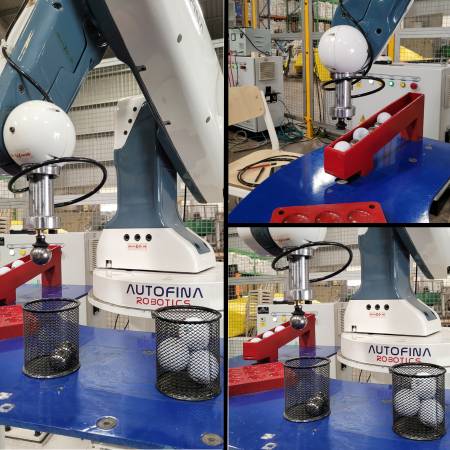

Material detecting robots can distinguish and categorize different materials with amazing precision just by using an array of modern sensors, such as tactile sensors for texture or infrared sensors for temperature. Their capacity to identify minute changes in composition or texture makes them super important in situations where material discrimination is critical. In industrial contexts where materials could be hazardous or toxic, these robots provide a protective role by reducing direct human involvement with potentially hazardous substances, resulting in a safer workplace.
Static Palletising Robot:
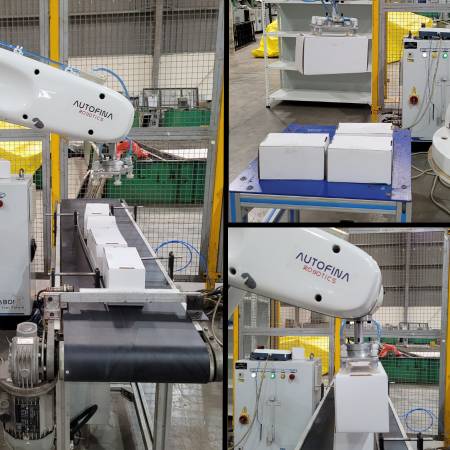

A Static Palletising Robot is a stationary robot that was created to automate the operation of placing products into pallets. Given its static nature, specialized high-speed methods can be performed in a specific area, making the palletising process quick and uniform. They are normally stationary, located at the end of a production or packaging line, and are set up to pick up products and drop them on a pallet in a specified pattern.
Magnetic Pick and Place Robot:


A Magnetic Pick and Place Robot is a trained robotic system that picks up, moves, and places ferrous(iron-containing) items using magnetic force. Unlike standard grippers or suction systems, this robot uses magnetism to hang onto its load, making it ideal for handling ferrous objects. When the robot wants to pick up something, the electromagnet is engaged, generating a powerful magnetic field that attracts and holds onto ferrous items. To release the item, turn off the electric current, which deactivates the magnet and allows the item to be placed or dropped. While it may appear to be a niche field, the knowledge and abilities gained from studying such robots have broad and far-reaching advantages.
Gluing Application Robot:
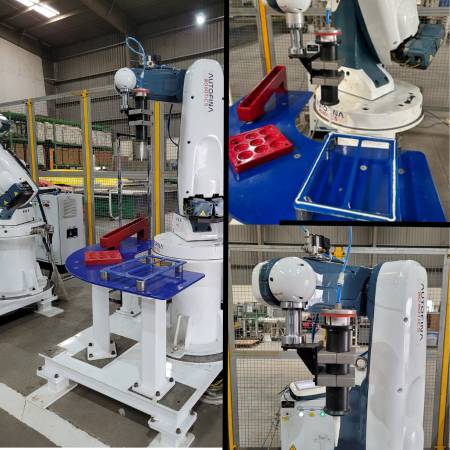

The Glueing Application Robot is a symbol of how precision engineering and automation can work together as today’s manufacturing demands rise. It’s made for applying adhesives consistently and precisely. It guarantees that the exact amount of glue is applied to particular areas on a product using cutting-edge sensors and dispensing systems. These robots increase production productivity, decrease adhesive waste, and guarantee constant product quality. They are often used in sectors like electronics and automotive. Understanding how consistently applying glue can influence the performance and longevity of the finished product goes beyond just the robot’s mechanics.
Logistic Sorting System:
This device quickly identifies goods based on their size, weight, destination, or other criteria and then sends them to the proper location or dispatch line using sensors, conveyors, and sophisticated algorithms. For example, Amazon’s fulfillment facilities use cutting-edge sorting technology to manage millions of items every day, making sure prompt deliveries to customers around the world. Similar technologies are used in airport baggage handling systems as well to guarantee that passengers’ bags board the correct flight. These technologies, which provide scalability, reduce manual labor, and lower sorting errors, become increasingly important as e-commerce and international trade rise.
Vacuum Gripping:
Vacuum Gripping is a technique that makes it possible to lift and move things, especially those with fragile, flat, or smooth surfaces, by using suction. They are adaptable to a variety of items, fostering safe and effective operations. Unlike conventional mechanical grippers, these grippers ensure less chance of injuring goods by dispersing force evenly. It is used by the packaging industry to safely lift and position goods like glass bottles or delicate things, preserving their integrity. Vacuum grippers help position big, smooth panels on auto assembly lines, speeding up the manufacturing process.
Spray Painting Robot:


Automotive paint applications have long made use of industrial paint robots. They are made to quickly and accurately coat surfaces with paint or other finishes. In addition to ensuring high finish quality, the use of spray painting robots also shortens production lead times, minimizes paint waste, and protects people from harmful fumes. Modern robotic spray painting arms come in a wide range of sizes and payloads to accommodate a variety of painting objects of various sizes.
Choose the Right Robotics with Autofina:


Bringing industrial robot manufacturing back to India, by taking over Tal Brabo, a subsidiary of Tata Motors, we have not only expanded our capabilities but also aim to make our commitment to providing top-notch robotics education globally extremely strong. Working in partnership with esteemed institutions like IIT Ropar, Anna University, IIT Goa among so many others has brought our vision to a reality. This has pushed our dream of spreading industrial robotics to a whole new level, one step closer.


Autofina have developed the most maintenance friendly industrial robots which allow hands on experience for every student. Princeton, Carnegie Mellon, MIT, Dresden Uni, Max Planck and countless others have used earlier versions of robots designed by us. We have honed our skills in designing robots that are easy to teach based on this very experience.
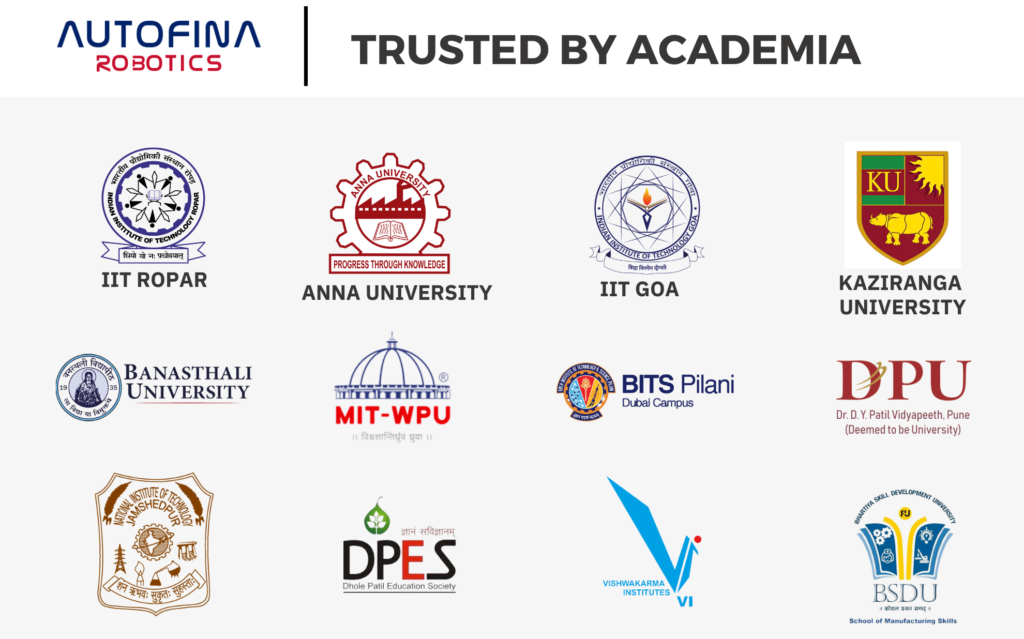

A subsidiary of Tata Motors manufactured our robots in India under license until 2021. Now, Autofina manufactures them at their plant in Pune, under the Make In India programme.


We are not just about heavy & complete easy-to-use robots. But we are also all about giving students of India the real feel of the fast-moving world of automation. Let us help you open up into the brilliant robotics world together!
Let’s take a look at some of the behind the scenes of how Autofina set up a cutting-edge industrial robotics lab at Manipal University. This lab is equipped with five state of the art robots, each representing the best of current robotic technology. These robots are designed to handle a diverse range of industrial tasks, showcasing over 20 different industrial applications. With the help of this setup at Manipal University, Autofina Robotics proves to be a testament to the growing landscape of industrial automation.

